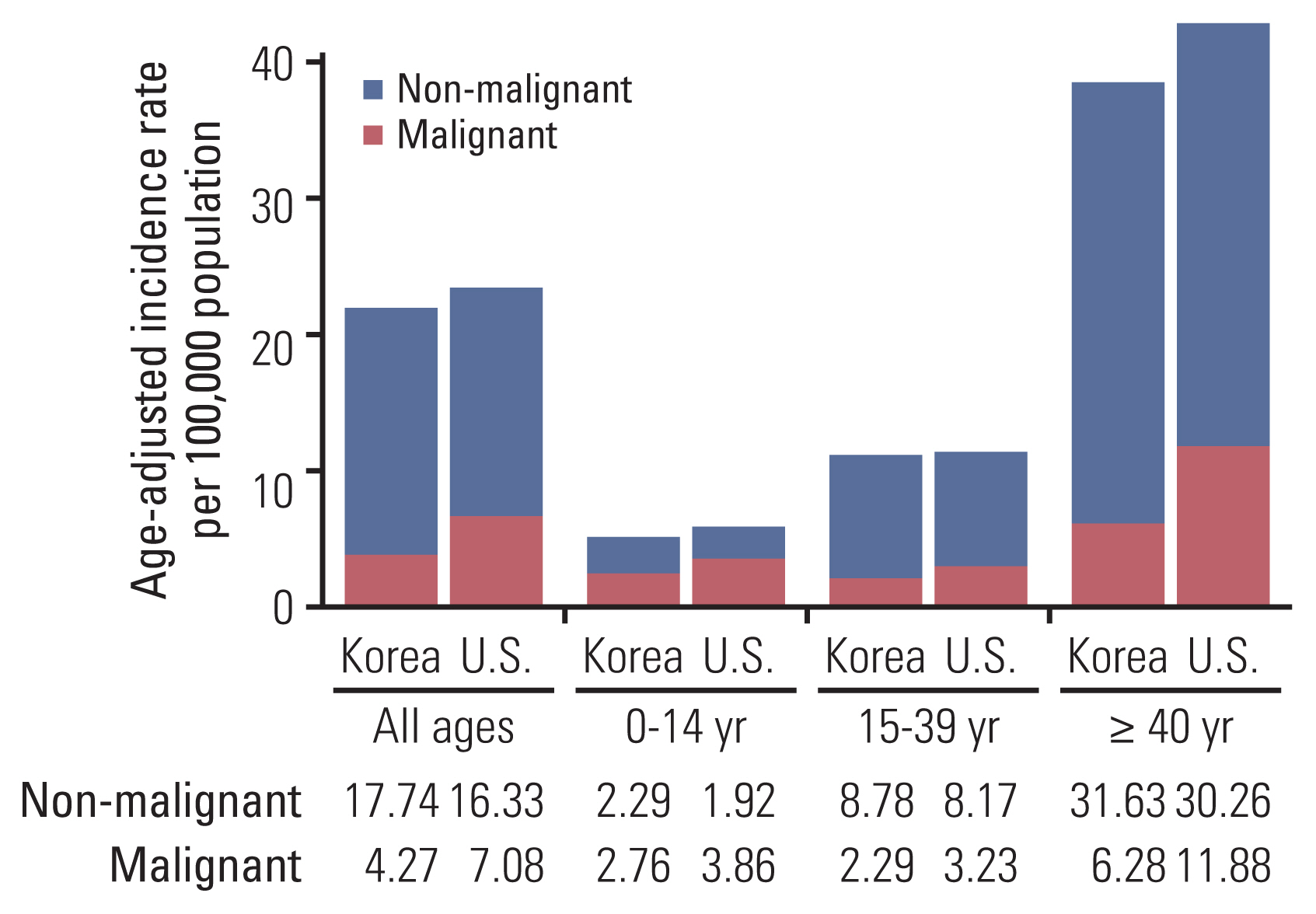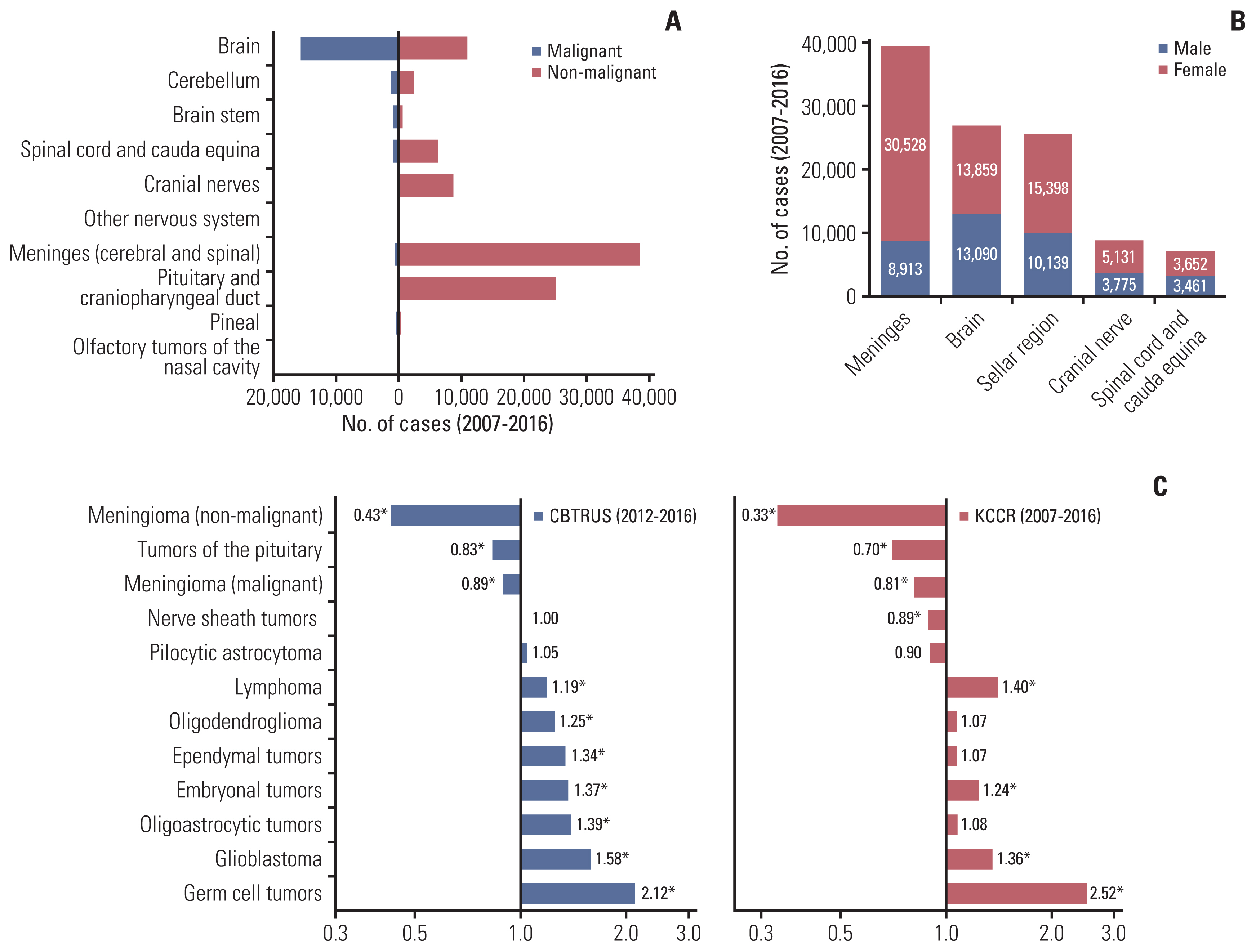Cancer Res Treat.
2021 Apr;53(2):355-366. 10.4143/crt.2020.847.
A Nationwide, Population-Based Epidemiology Study of Primary Central Nervous System Tumors in Korea, 2007-2016: A Comparison with United States Data
- Affiliations
-
- 1Department of Neurosurgery, Seoul National University Hospital, Seoul, Korea
- 2Department of Neurosurgery, Gangneung Asan Hospital, Gangneung, Korea
- 3Division of Cancer Registration and Surveillance, National cancer center, Goyang, Korea
- 4Department of Cancer Control and Population Health, National cancer center, Goyang, Korea
- 5Neuro-Oncology clinic, National cancer center, Goyang, Korea
- KMID: 2514918
- DOI: http://doi.org/10.4143/crt.2020.847
Abstract
- Purpose
The purpose of this study was to determine the epidemiologic characteristics and survival of patients with primary brain and other central nervous system (CNS) tumors in Korea and to compare our findings with those from the United States.
Materials and Methods
We collected data on primary brain and CNS tumors diagnosed between 2007 and 2016 from the Korea Central Cancer Registry. The age-standardized incidence rates (ASRs) and 5-year relative survival rates (RSRs) were evaluated. We applied the classification and definitions of the Central Brain Tumor Registry of the United States to our analysis for direct comparison with United States data.
Results
A total of 115,050 primary brain and CNS tumors were identified, and the ASR of all tumors was 22.01 per 100,000 individuals, which was lower than the 23.41 in the United States. However, the ASR of malignant tumors was significantly lower herein (4.27) than in the United States (7.08). Meningeal tumors were the most common histologic group among all tumors (ASR, 8.32). The 5-year RSR of all primary brain and other CNS tumors was 86.4%, and that of all malignant tumors was 44.1%, which was higher than the 35.8% observed in the United States. Among malignant tumors, glioblastomas had the lowest 5-year RSR (12.1%).
Conclusion
In Korea, malignant brain and other CNS tumors have a lower incidence and better survival outcome.
Keyword
Figure
Cited by 1 articles
-
Anaplastic Meningioma: Clinical Characteristics, Prognostic Factors and Survival Outcome
Dong Ok Seo, Sang Woo Song, Young-Hoon Kim, Chang-Ki Hong, Jeong Hoon Kim
Brain Tumor Res Treat. 2022;10(4):244-254. doi: 10.14791/btrt.2022.0030.
Reference
-
References
1. Fritz A, Percy C, Jack A, Shanmugaratnam K, Sobin L, Parkin DM, et al. International Classification of Diseases for Oncology (ICD-O). 3rd ed. Geneva: World Health Organization;2000.2. Ostrom QT, Cioffi G, Gittleman H, Patil N, Waite K, Kruchko C, et al. CBTRUS statistical report: primary brain and other central nervous system tumors diagnosed in the United States in 2012–2016. Neuro Oncol. 2019; 21:v1–100.
Article3. Altekruse SF, Kosary CL, Krapcho M, Neyman N, Aminou R, Waldron W, et al. SEER cancer statistics review, 1975–2007. Bethesda, MD: National Cancer Institute;2010.4. Lee CH, Jung KW, Yoo H, Park S, Lee SH. Epidemiology of primary brain and central nervous system tumors in Korea. J Korean Neurosurg Soc. 2010; 48:145–52.
Article5. Jung KW, Ha J, Lee SH, Won YJ, Yoo H. An updated nationwide epidemiology of primary brain tumors in republic of Korea. Brain Tumor Res Treat. 2013; 1:16–23.
Article6. Dho YS, Jung KW, Ha J, Seo Y, Park CK, Won YJ, et al. An updated nationwide epidemiology of primary brain tumors in Republic of Korea, 2013. Brain Tumor Res Treat. 2017; 5:16–23.
Article7. Jung KW, Won YJ, Kong HJ, Lee ES. Cancer statistics in Korea: incidence, mortality, survival, and prevalence in 2016. Cancer Res Treat. 2019; 51:417–30.
Article8. Korean Statistical Information Service [Internet]. Daejeon: Korean Statistics;2019. [cited 2020 Jan 10]. Available from: http://kosis.kr.9. Kaneko S, Nomura K, Yoshimura T, Yamaguchi N. Trend of brain tumor incidence by histological subtypes in Japan: estimation from the Brain Tumor Registry of Japan, 1973–1993. J Neurooncol. 2002; 60:61–9.10. Wohrer A, Waldhor T, Heinzl H, Hackl M, Feichtinger J, Gruber-Mosenbacher U, et al. The Austrian Brain Tumour Registry: a cooperative way to establish a population-based brain tumour registry. J Neurooncol. 2009; 95:401–11.
Article11. Sant M, Minicozzi P, Lagorio S, Borge Johannesen T, Marcos-Gragera R, Francisci S, et al. Survival of European patients with central nervous system tumors. Int J Cancer. 2012; 131:173–85.
Article12. Jazayeri SB, Rahimi-Movaghar V, Shokraneh F, Saadat S, Ramezani R. Epidemiology of primary CNS tumors in Iran: a systematic review. Asian Pac J Cancer Prev. 2013; 14:3979–85.
Article13. de Robles P, Fiest KM, Frolkis AD, Pringsheim T, Atta C, St Germaine-Smith C, et al. The worldwide incidence and prevalence of primary brain tumors: a systematic review and meta-analysis. Neuro Oncol. 2015; 17:776–83.
Article14. Chien LN, Gittleman H, Ostrom QT, Hung KS, Sloan AE, Hsieh YC, et al. Comparative brain and central nervous system tumor incidence and survival between the United States and Taiwan based on population-based registry. Front Public Health. 2016; 4:151.
Article15. Miranda-Filho A, Pineros M, Soerjomataram I, Deltour I, Bray F. Cancers of the brain and CNS: global patterns and trends in incidence. Neuro Oncol. 2017; 19:270–80.
Article16. Darlix A, Zouaoui S, Rigau V, Bessaoud F, Figarella-Branger D, Mathieu-Daude H, et al. Epidemiology for primary brain tumors: a nationwide population-based study. J Neurooncol. 2017; 131:525–46.
Article17. Lin YJ, Chiu HY, Chiou MJ, Huang YC, Wei KC, Kuo CF, et al. Trends in the incidence of primary malignant brain tumors in Taiwan and correlation with comorbidities: a population-based study. Clin Neurol Neurosurg. 2017; 159:72–82.
Article18. Pouchieu C, Gruber A, Berteaud E, Menegon P, Monteil P, Huchet A, et al. Increasing incidence of central nervous system (CNS) tumors (2000–2012): findings from a population based registry in Gironde (France). BMC Cancer. 2018; 18:653.
Article19. Nakamura H, Makino K, Yano S, Kuratsu JI. Kumamoto Brain Tumor Research Group. Epidemiological study of primary intracranial tumors: a regional survey in Kumamoto prefecture in southern Japan--20-year study. Int J Clin Oncol. 2011; 16:314–21.
Article20. Bray F, Ferlay J, Soerjomataram I, Siegel RL, Torre LA, Jemal A. Global cancer statistics 2018: GLOBOCAN estimates of incidence and mortality worldwide for 36 cancers in 185 countries. CA Cancer J Clin. 2018; 68:394–424.
Article21. Woehrer A, Hackl M, Waldhor T, Weis S, Pichler J, Olschowski A, et al. Relative survival of patients with non-malignant central nervous system tumours: a descriptive study by the Austrian Brain Tumour Registry. Br J Cancer. 2014; 110:286–96.
Article22. Ward E, Jemal A, Cokkinides V, Singh GK, Cardinez C, Ghafoor A, et al. Cancer disparities by race/ethnicity and socioeconomic status. CA Cancer J Clin. 2004; 54:78–93.
Article23. Woehrer A. Brain tumour epidemiology in Austria and the Austrian brain tumour registry. Clin Neuropathol. 2013; 32:269–85.24. Bruhn H, Strandeus M, Milos P, Hallbeck M, Vrethem M, Lind J. Improved survival of Swedish glioblastoma patients treated according to Stupp. Acta Neurol Scand. 2018; 138:332–7.
Article25. Glied S, Jackson A. The future of the affordable care act and insurance coverage. Am J Public Health. 2017; 107:538–40.
Article26. Thakkar JP, Dolecek TA, Horbinski C, Ostrom QT, Lightner DD, Barnholtz-Sloan JS, et al. Epidemiologic and molecular prognostic review of glioblastoma. Cancer Epidemiol Biomarkers Prev. 2014; 23:1985–96.
Article
- Full Text Links
- Actions
-
Cited
- CITED
-
- Close
- Share
- Similar articles
-
- Epidemiology of Primary Brain and Central Nervous System Tumors in Korea
- An Updated Nationwide Epidemiology of Primary Brain Tumors in Republic of Korea
- Nationwide Population-Based Incidence and Survival Rates of Malignant Central Nervous System Germ Cell Tumors in Korea, 2005-2012
- Newly-Diagnosed, Histologically-Confirmed Central Nervous System Tumours in a Regional Hospital in Hong Kong : An Epidemiological Study of a 21-Year Period
- An Updated Nationwide Epidemiology of Primary Brain Tumors in Republic of Korea, 2013




